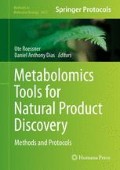Abstract
Liquid chromatography-mass spectrometry (LC-MS or HPLC-MS) is an extremely sensitive analytical technique that enables the detection of metabolites with a vast range of chemistries and molecular masses. Extracts from any biological starting material are first fractionated chromatographically on a stationary phase suitable for the retention of the target molecules. The eluent is then transferred directly to the ionization source for MS detection. There is a vast range of chromatographic separation methods and MS configurations. This chapter describes a method for the detection of a broad range of metabolites using reversed phase (C18) LC-MS as well as a method for the isolation of targeted metabolites of interest.
Access this chapter
Tax calculation will be finalised at checkout
Purchases are for personal use only
References
Zhou B, Xiao JF, Tuli L et al (2012) LC-MS-based metabolomics. Mol Biosyst 8:470–481
Watson JT, Sparkman OD (2008) Introduction to mass spectrometry. Instrumentation, applications and strategies for data interpretation, 4th edn. Wiley, Chichester, NY
Nakabayashi R, Kusano M, Kobayashi M et al (2009) Metabolomics-oriented isolation and structure elucidation of 37 compounds including two anthocyanins from Arabidopsis thaliana. Phytochemistry 70:1017–1029
Vuckovic D (2012) Current trends and challenges in sample preparation for global metabolomics using liquid chromatography-mass spectrometry. Anal Bioanal Chem 403:1523–1548
Lu W, Bennett BD, Rabinowitz JD (2009) Analytical strategies for LC-MS-based targeted metabolomics. J Chromatogr B Analyt Technol Biomed Life Sci 871:236–242
Ellis DI, Dunn WB, Griffin JL et al (2007) Metabolic fingerprinting as a diagnostic tool. Pharmacogenomics 8:1243–1266
De Vos RCH, Moco S, Lommen A et al (2007) Untargeted large-scale plant metabolomics using liquid chromatography coupled to mass spectrometry. Nat Protoc 2:778–791
Rojo D, Barbas C, Ruperez FJ (2012) LC-MS metabolomics of polar compounds. Bioanalysis 4:1235–1243
Keller BO, Sui J, Young AB et al (2008) Interferences and contaminants encountered in modern mass spectrometry. Anal Chim Acta 627:71–81
Zelena E, Dunn WB, Broadhurst D et al (2009) Development of a robust and repeatable UPLC − MS method for the long-term metabolomic study of human serum. Anal Chem 81:1357–1364
van den Berg R, Hoefsloot H, Westerhuis J et al (2006) Centering, scaling, and transformations: improving the biological information content of metabolomics data. BMC Genomics 7:142
Pluskal T, Castillo S, Villar-Briones A et al (2010) MZmine 2: modular framework for processing, visualizing, and analyzing mass spectrometry-based molecular profile data. BMC Bioinformatics 11:1471–2105
Smith CA, Want EJ, O’Maille G et al (2006) XCMS: processing mass spectrometry data for metabolite profiling using nonlinear peak alignment, matching, and identification. Anal Chem 78:779–787
Lommen A, Kools H (2012) MetAlign 3.0: performance enhancement by efficient use of advances in computer hardware. Metabolomics 8:719–726
Howlett BJ, Idnurm A, Pedras MS (2001) Leptosphaeria maculans, the causal agent of blackleg disease of Brassicas. Fungal Genet Biol 33:1–14
Fiehn O, Sumner L, Ward J, Rhee SY, Dickerson J, Lange M, Lane G, Roessner U, Last R, Nikolau B (2007) Minimum reporting standards for plan biology context in metabolomic studies. Metabolomics 3, 195–201
Author information
Authors and Affiliations
Editor information
Editors and Affiliations
Rights and permissions
Copyright information
© 2013 Springer Science+Business Media, LLC
About this protocol
Cite this protocol
Callahan, D.L., Elliott, C.E. (2013). A Workflow from Untargeted LC-MS Profiling to Targeted Natural Product Isolation. In: Roessner, U., Dias, D. (eds) Metabolomics Tools for Natural Product Discovery. Methods in Molecular Biology, vol 1055. Humana Press, Totowa, NJ. https://doi.org/10.1007/978-1-62703-577-4_5
Download citation
DOI: https://doi.org/10.1007/978-1-62703-577-4_5
Published:
Publisher Name: Humana Press, Totowa, NJ
Print ISBN: 978-1-62703-576-7
Online ISBN: 978-1-62703-577-4
eBook Packages: Springer Protocols

